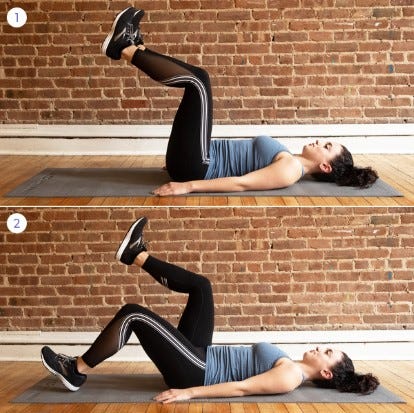10 BEST POSTPARTUM WORKOUT MOVES FOR NEW MOMS

Experts at the American College of Obstetricians and Gynecologists (ACOG) recommend aiming for at least 150 minutes of moderate-intensity aerobic activity — i.e. anything that bumps up your heart rate and makes you break a sweat, like brisk walking or bike riding — every week, along with two days of strength training (which includes yoga, Pilates and lifting weights).
But Don’t jump into a postpartum exercise routine without your doctor’s approval. Many doctors recommend waiting six to eight weeks after birth before starting to try any type of exercise, but it often varies. Some women may experience complications during pregnancy or labor that might set them back a few more weeks.
Your body is still healing from delivery, and with a newborn in the house, you might be feeling more tired than ever. But finding time to fit in fitness is amazing for both your body and mind — it can be just what you need to get back to feeling like your pre-pregnancy self. No, we’re not talking about “getting your body back.” We’re talking about a boost to your energy, self-confidence, and physical strength. Plus, you’re bound to sleep better too. After that slowly you can start your workout after consulting a doctor and get your body fit in shape.
Each of these exercises gets a little harder as you go on. So feel comfortable and work your way up to doing about 20 repetitions of each exercise if you are comfortable with it, and then add the next one to your routine. Now let scroll down to see the 10 simple postpartum exercises to get fit as you were.
BRIDGES:

Step 1: Lie on the floor. Your spine should be against the ground, with knees bent at a 90-degree angle, feet flat, and arms straight at your sides with palms facing down.
Step 2: Inhale and push through your heels, raising your hips off the ground by squeezing your glutes, hamstrings, and pelvic floor. Your body — resting on your upper back and shoulders — should form a straight line down from the knees.
Step 3: Pause 1–2 seconds at the top and return to the starting position.
Step 4: Complete 10–15 reps and 2–3 sets, resting 30–60 seconds between sets.
FOUR POINT KNEELING:

Step 1: Kneel on all fours and take a deep breath.
Step 2: Squeeze your abs as you breathe out.
DIAPHRAGMATIC BREATHING:

Step 1: Begin in a supine position (on your back) with your legs extended straight out and your arms relaxed by your side.
Step 2: Inhale and fill your belly up. Then exhale all the air out as you press your lower back into the ground. It’s a gentle postpartum ab workout and promotes relaxation.
LEG SLIDES:

Step 1: Lie on your back with your knees bent.
Step 2: Engage your abs and slide one foot along the floor until your leg is straight.
Step 3: Then bring the leg back into the starting position and switch to the other leg.
WALKING:

Step 1: Do a five-minute warm-up by marching in place.
Step 2: Strength-train every other day.
Step 3: Aim to walk 30 to 45 minutes a day.
Step 4: New moms Vary your workout for the best results. Try interval training by speeding up your pace for two minutes, then walking at a more moderate one for the next two, continuing the pattern throughout your walk.
Step 5: At the end of your walk, cool down at a slower pace for five minutes.
Step 6: Stretch thoroughly.
HEEL TOUCHES:

Step 1: Next, bend both knees above your hips, keeping your calves parallel to the floor. ower one heel to the floor while keeping your knee bent. Bring the leg back up to 90 degrees and touch the other heel to the floor.
Step 2: A harder version is to touch both heels to the floor at the same time. The key is to keep your back pressed to the floor, don’t let your lower back arch as you dip your heels.
Step 3: If you find your back arching, don’t go down all the way to the floor; instead, lower your heel only as low as you can without arching your back.
CAT AND COW:

Step 1: Begin on all fours with your shoulders stacked directly above your hands and your hips stacked directly above your knees.
Step 2: Arch your back up, drawing your navel in, and let your head hang to the cat. Then press your belly toward the ground and bring your head and gaze to the sky to cow.
Step 3: Repeat this, alternating cat and cow, for 10 reps. This works your core and helps stretch the muscles in your back and neck.
LEG EXTENSIONS:

Step 1: Staying on your back, raise and bend your legs so that your knees are bent over your hips, keeping your calves parallel to the floor.
Step 2: Straighten one of your legs out so that the leg is diagonal and your foot is hovering one to two feet above the floor.
Step 3: Bring your leg back and do the same with the other leg.
BIRD DOG:

Step 1: Starting off on all four (hands and knees) slowly breathe out as you gently draw your belly button towards your spine. You should begin to feel some slight tightening of your lower abdominal muscles after a few repetitions.
Step 2: Slowly release after holding for 3 or 4 breaths (remember not to hold your breath!). This is the first step in your “strengthening” program. Practice this exercise until you can comfortably hold this light lower abdominal contraction about 10 to 15 times.
Step 3: Once achieved you can begin to progress. This would include raising one arm at a time and holding for about 5 seconds all while maintaining your lower abdominal contraction. To progress further you can extend your leg back.
KNEE RAISES:

Step 1: Stay in the leg slide position, and raise one leg bending the knee above the hip.
Step 2: Straighten out your other leg.
Step 3: Then “cycle” the legs by bending the straight leg and straightening the bent leg.
NOTE:
Always have a personal trainer or coach for yourself, who knows the nook and corner of your body conditions, and then start your training. Try out this weight loss training (Click Here to Start The Training And Shape Yourself With Proper Guidance Of A Coach).
See Your Healthcare Provider If…
Before starting to exercise again, it’s safest to ask your provider for the OK. Once you start exercising, stop exercising and contact your provider if you
· experience pain
· feel faint or nauseous
· have vaginal bleeding
· get unusually short of breath (not associated with the workout itself)
· feel extremely tired
· have any other concerns.
You May Also Know About:
5 HEALTHY HABITS OF A FIT WOMEN
10 MINS YOGA POSES FOR WEIGHT LOSS
8 EFFECTIVE GYM WORKOUT FOR BEGINNERS
7 BEST INTENSIVE THIGH WORKOUT TO GET TONED THIGHS
5 HEALTHY DESSERT RECIPES THAT DOESN'T RUIN YOUR DIET
